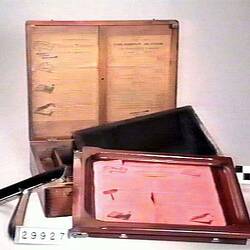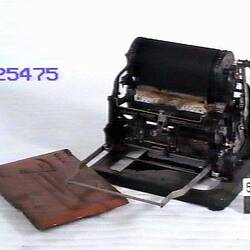Summary
Edison mimeograph duplicator.
The stencil duplicator, or mimeograph machine, along with spirit duplicators and hectographs, were from the late 19th Century used for small jobs in the office, school and church.. They were replaced by photocopying in the 1960s.
Waxed mulberry paper is used with a backing of stiff card stock, bound at the top. A typewriter, without the ribbon in place, is used to create the original.The effect is to remove the wax where the type hammer has hit, making the paper permeable to oil-based ink. This is called "cutting a stencil."
A variety of specialized styluses can be used on the stencil to render lettering or illustrations by hand against a toothy plastic backing card. Mistakes can be corrected with correction fluid and retyping once it has dried.
Box fitted to hold metal tube of ink, cardboard cylinder containing stencil paper, stylus and wooden roller. Above these are slate to hold ink, frame with steel plate over slate for inscribing stencil and for printing.
There is also a sheet of paper with 'Facts for the public' and advertisements on one side, and other side 'Description of mimeograph.
Attached to the inside of the lid is a sheet of paper with 'Directions' and 'Price list'
Physical Description
Wooden box with enamel label on lid "Sold by the EDISON MIMEOGRAPH C0 LONDON ENGLAND" The duplicator box also contains: Roll of mimeograph stencil paper in a tube Stylus Collapsible tube of ink Roller Injking plate Printing frame Sheet of paper with 'Facts for the public' and advertisements on one side, and other side 'Description of mimeograph'
More Information
-
Collecting Areas
-
Acquisition Information
Purchase
-
Maker
Edison Mimeograph Co, London, England, Great Britain, post 1876
-
Inscriptions
Lid: Sold by the/EDISON/MIMEOGRAPH CO/LONDON, ENGLAND Manual has '1887 Patent' Embossed on printing frame: Patents/Aug 8 76/Feb 17 80/May 28 89/No 1 Attached to the inside of the lid is a sheet of paper with 'Directions' and 'Price list'
-
Classification
-
Category
-
Discipline
-
Type of item
-
Overall Dimensions
43 cm (Length), 34 cm (Width), 11.5 cm (Height)
-
Exhibition Collection Management
336 mm (Length), 432 mm (Width), 118 mm (Height)
-
References
[Link 1] - accessed 12 November 2008 [Link 2] - accessed 12 November 2008
-
Keywords



